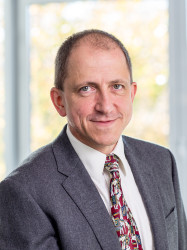Summary
Until 2017, Peter Kohl held the Chair in Cardiac Biophysics and Systems Biology at NHLI. Having relocated to Germany, to set up the new institute for Experimental Cardiovascular Medicine at the University of Freiburg, he is now a Visiting Professor at NHLI.
Peter studied Medicine and Biophysics at the Moscow Pirogov Institute and, after post-graduate training and research at the Berlin Charité (PhD 1990, Facharzt 1991), he joined the Cardiac Electrophysiology Chair of Professor Denis Noble at Oxford. In 1998, Peter set up the Oxford Cardiac Mechano-Electric Feedback lab, initially as a Royal Society Research Fellow, and subsequently as a Senior Fellow of the British Heart Foundation. While at Oxford, he held a Research Fellowship at Keble College (2002-2004) and was the Tutorial Fellow in Biomedical Sciences at Balliol (2004-2010).
Peter’s team enjoys a strong international reputation in cardiac mechano-electrical interaction studies, in particular as a result of their ability to cross traditional boundaries between fields (engineering, biophysics, biology, computing) and levels (ion channel to whole organ) of investigation. Building on a solid track-record in the development and application of novel techniques, they combine experiment and computation to integrate cardiac structure-function data to address clinically-relevant research targets.
Peter directs a significant portfolio of externally-funded research (supported in recent years by German Research Foundation, ERC, BHF and BBSRC), and has been a driver of international collaboration actions, such as the Network of Excellence for the EU Virtual Physiological Human Initiative whose co-founding director he was. Peter is the coordinating editor of the primary textbook on Cardiac Mechano-Electric Coupling and Arrhythmias, and chairman of the leading international workshop series on the topic.
For more detail, please see Peter's Inaugural Lecture at Imperial College, and a recent review on the Institute for Experimental Cardiovascular Medicine in Freiburg.
Camelliti et al. Fibroblast network in rabbit sinoatrial node: structural and functional identification of homogeneous and heterogeneous cell coupling. Circ Res 2004/94:828-35.
Publications
Journals
Fürniss HE, Wülfers EM, Iaconianni P, et al., 2024, Disease severity, arrhythmogenesis, and fibrosis are related to longer action potentials in tetralogy of Fallot., Clin Res Cardiol, Vol:113, Pages:716-727
Simon-Chica A, Klesen A, Emig R, et al., 2024, Piezo1 stretch-activated channel activity differs between murine bone marrow-derived and cardiac tissue-resident macrophages., J Physiol
Scardigli M, Pásek M, Santini L, et al., 2024, Optogenetic confirmation of transverse-tubular membrane excitability in intact cardiac myocytes., J Physiol, Vol:602, Pages:791-808
Sassu E, Tumlinson G, Stefanovska D, et al., 2024, Age-related structural and functional changes of the intracardiac nervous system., J Mol Cell Cardiol, Vol:187, Pages:1-14
Kohl P, 2023, Hello, Goodbye., J Physiol, Vol:601, Pages:4645-4646

